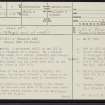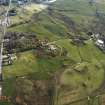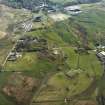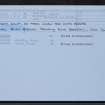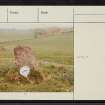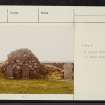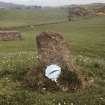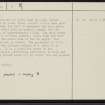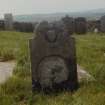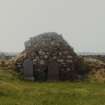Islay, Kilmeny, Old Parish Church
Burial Ground (Medieval), Cross (Medieval)(Possible), Grave Slab(S) (Medieval), Gravestone(S) (18th Century), Parish Church (Medieval), Standing Stone (Prehistoric)(Possible)
Site Name Islay, Kilmeny, Old Parish Church
Classification Burial Ground (Medieval), Cross (Medieval)(Possible), Grave Slab(S) (Medieval), Gravestone(S) (18th Century), Parish Church (Medieval), Standing Stone (Prehistoric)(Possible)
Alternative Name(s) Cill A' Mhanaich; Cill Mheinidh
Canmore ID 37709
Site Number NR36NE 7
NGR NR 38862 65323
Datum OSGB36 - NGR
Permalink http://canmore.org.uk/site/37709
- Council Argyll And Bute
- Parish Killarow And Kilmeny
- Former Region Strathclyde
- Former District Argyll And Bute
- Former County Argyll
NR36NE 7 3885 6532.
(NR 3885 6532) Cill a' Mhanaich (NR) Chapel (NR) (In Ruins)
OS 6" map, Argyllshire, 2nd ed., (1900)
Cill a' Mhanaich. A graveyard still in use (ONB 1878) in which stands a fragment of a chapel. On a hillock outside is the stump of a pillar, probably the remains of a cross (Muir 1885, Islay Archaeol Survey 1959). Nothing is known of the history of the chapel but the lands were held by the Bishop of the Isles in 1561 (OPS 1855).
Name Book 1878; T S Muir 1885; Orig Parch Scot 1854; Islay Archaeol Survey 1959.
The Gaelic form of the name is Cill Mheinidh, for Cill Mh'Eithne, 'my Eithne's Church', but there is no indication which saint of that name is commemorated.
W J Watson 1926.
Only the west gable is standing though a few traces of building at the east end show it to have been about 50ft long. Three carved stones lie in the churchyard to the south of the church.
R C Graham 1895.
The west gable-end is 2.5m high by 6.5m across and the wall is 1.0m thick; bonded rubble core protruding through the turf is presumed the east gable remains and would give an overall length for the chapel, E-W, of approximately 11.5m. The only other wall traces is a 4.0m stretch, 1.0m high and turf covered, in the south side at the SW angle. The carved stones are as noted. The graveyard is still in use, and the alleged remains of a cross is at NR 3891 6525. It is a slab-like stone in the NE end of a knoll, protruding vertically to 0.6m and measuring at ground level 0.3 by 0.35m; the end appears broken off.
Surveyed at 1:2500.
Visited by OS (J M) 21 June 1978.
Field Visit (August 1977)
NR 388 653. The surviving fragment of this medieval church stands in the W half of a walled burial-ground about 400m SW of the present parish church (RCAHMS 1984, No. 371). The visible remains consist of part of the W wall and an adjacent turf-covered portion of the s side-wall extending eastwards for a distance of some 3.5m. The extant portion of the w wall measures 5.5m in length by 0.9m in average thickness and 2.6m in maximum internal height. It is constructed of lime-mortared rubble masonry, which has been partly rebuilt, and on the external face of the wall towards the S end there is a narrow semicircular arch of 0.65m span which is composed of dressed voussoirs. A stone of the inner face bears the incised inscription DUNCAN MCNAB 1769, probably marking a family burial-place.
Kilmeny was described by Monro in 1549 as one of the four parish churches of Islay, but no earlier reference has been identified and it is possible that it originated as a dependent chapel within the parish of Kilarrow (RCAHMS 1984, No. 359). The lands of Kilmeny belonged to the Bishop of the Isles, but the bishopric rental of 1561 did not lay claim to the church, and the patronage of the benefice is unknown. (Monro; Cowan;) The dedication may have been to St Eithne, a familiar Old Irish female name. (Watson 1926, quoting the Gaelic form Cill Mheinidh. The name Cill a' Mhanaich {burial-ground of the monk} is used on a panel recording the rebuilding of the churchyard wall in 1876, and was adopted by the Ordnance Survey two years later {Name Book 1878) The exiguous remains described above may belong to the later Middle Ages.
The following monuments are in the W half of the burial-ground. Number 2 could not be located at the date of visit.
Medieval
(1) Tapered slab bordered by a single moulding, 1.79m by 0.49m, much worn. At the top there are traces of a foliated cross, followed by two confronted animals from whose tails issues an overall pattern of intertwined plant-stems. (Graham, 1895). lona school, 14th-15th century.
(2) Tapered slab bordered by a triple moulding 1.72m in incomplete length by about 0.48m; when recorded by Graham, it was damaged at the top right corner and the foot. At the top there was a rectangular panel framed in chevron ornament, followed by two confronted animals from whose tails issued an overall pattern of intertwined plant-stems. (Graham,1895). Loch Awe school, 14th-15th century.
(3) Tapered slab bordered by a double moulding containing nail-head ornament,1.87m by 0.49m; it is much worn and the top left corner is missing. At the centre there is a sword with lobated pommel and inclined quillons, and to the left a plain panel, probably once inscribed, above the quillon and a plant-scroll terminating in an animal's head below it. Above the right quillon is an animal, and below it another animal and then a plain panel, while at the foot of the slab is a dragonesque creature. (Graham,1895). 14th-15th century.
(4) Tapered slab, 1.77m by 0.46m, bearing faint traces of a sword. The remainder of the original decoration has been obliterated by later ornament and an inscription commemorating John Currie who died in 1823. 14th-early 16th century.
(5) Fragment of the moulded edge of a slab, 0.7m by 0.32m, bearing traces of foliaceous ornament, 14th-early 16th century.
Post-Reformation
(6) Several tapered slabs bordered by double roll-mouldings. One bears the inscription JOHN MCKEOUN HIS
BURIALL / PLACE 1712, and it is probable that all are of post-Reformation date.
(7) Headstone commemorating Andrew MacLean, innkeeper at Robolls, who died in 1748.
(8) Headstone erected to the memory ofNeil McQuillan, who died in 1762, and his wife, Elizabeth Campbell, who died in 1776.
(9) Much-worn recumbent slab commemorating Hugh MacDougall, tacksman in Bar, who died in 17[ ]7.
(10) Large recumbent slab carved in low relief with a shield bearing quarterly: 1st, gyronny of eight; 2nd, indecipherable; 3rd, ?a galley; 4th, a mullet. The principal inscription is effaced, but a subsidiary inscription at the foot mentions Peter, son of John Campbell of Ballygrant.
RCAHMS 1984, visited August 1977.















